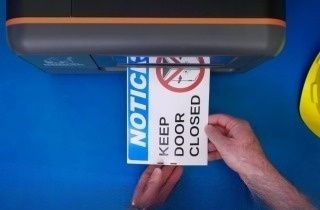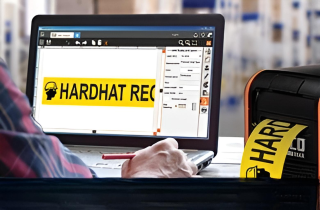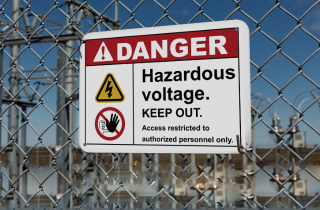Why OSHA Required Floor Marking Fails in Summer

Why Does Floor Marking Tape Fail More Often in Summer?
Floor marking tape fails more frequently in summer because heat, humidity, UV exposure, and increased traffic strain adhesives and materials. High temperatures soften the glue, moisture undermines the bond, and sunlight fades colors. The result is peeling, shifting, and loss of visibility in areas that need to stay clearly marked.
The sections below explain what summer conditions do to tape, where failures happen fastest, and how to prevent repeat replacements.
-
How heat and humidity break down tape adhesion
-
Why UV and cleaning cycles speed up wear
-
The areas most likely to fail first in summer
-
What heat-resistant tape materials work best
-
Seasonal application tips that improve lifespan
These failures do more than look messy. When tape lifts or fades, OSHA-required markings can disappear with it, leaving workers without clear guidance for safe paths, hazard zones, or equipment boundaries. Facilities that depend on visual communication can prevent these issues by using heat-resistant supplies and seasonal application best practices.
The Summer Strain on Floor Marking Tape
Floor marking tape is essential for guiding traffic, defining walkways, and separating hazard zones. But in hot weather, even high-quality tape faces extra stress.
- Heat weakens adhesives: Prolonged exposure to high temperatures causes adhesives to soften, leading to peeling and bubbling.
- Moisture undermines adhesion: Summer humidity and condensation around loading docks or refrigerated areas allow tape edges to lift.
- UV exposure fades tape: Sunlight streaming through skylights or open bay doors dulls colors and reduces visibility.
- Traffic amplifies damage: Forklifts, pallet jacks, and heavy pedestrian traffic exploit weakened surfaces, tearing tape more quickly.
Consider a warehouse in Texas where summer temperatures regularly reach triple digits. Forklifts crossing tape lines multiple times per hour caused bubbling within days, creating trip hazards and disrupting workflow. This example highlights how quickly floor tape durability can break down under extreme seasonal conditions.
Why Floor Marking Tape Matters for Summer Workplace Safety
The Occupational Safety and Health Administration (OSHA) requires safe walking and working surfaces under 29 CFR 1910.22. Floor marking tape plays a direct role in compliance by defining aisles, exits, and hazard areas.
When tape deteriorates in the summer:
- Faded walkways: Blend into concrete and lose visibility.
- Exits: Become harder to locate in emergencies.
- Forklift lanes: Develop bubbling or peeling edges that create uneven surfaces.
Without reliable visual cues, workers face higher risks of slips, trips, and missteps. In fast-moving environments, these failures translate into preventable accidents and regulatory citations. Clear, durable floor marking tape is essential for keeping workplace safety intact during the most demanding months.
How Heat Affects Floor Marking Tape on Different Surfaces
Summer heat doesn’t impact every floor the same way. Adhesion depends heavily on the surface material, and facilities with mixed flooring often experience inconsistent performance.
- Concrete: Expansion and contraction loosen bonds and allow dust to interfere with adhesion.
- Epoxy-coated floors: Provide less grip in hot conditions, causing tape to slide before setting properly.
- Polished or sealed floors: Present the toughest challenge. High-gloss finishes resist bonding, and in the summer, tape edges often curl under traffic stress.
By recognizing these differences, supervisors can choose heat-resistant adhesives tailored to each surface type. Proper surface preparation further helps maintain consistent floor tape durability across all areas of the facility.

What is the Best Anti-Slip Floor Tape for Heat and High Traffic?
Not all floor tape performs equally in hot conditions. Facilities that experience repeated summer failures should consider anti-slip floor tape engineered for heat and abrasion resistance.
These tapes use stronger adhesives and textured surfaces that extend performance in harsh environments. The textured finish improves worker footing in zones where condensation builds, such as near dock entrances or refrigeration units.
Heat-resistant adhesives hold their bond at higher temperatures, while UV-stable colors maintain visibility in areas exposed to sunlight. In fast-paced facilities, these qualities make anti-slip tape a reliable option for protecting both workers and the visual systems that keep operations moving.
Floor Tape vs. Floor Paint in Hot Conditions
Some facilities consider floor paint instead of tape, believing it might last longer under heat. While paint can provide a more permanent look, it introduces its own challenges during summer.
- Extended curing times: High temperatures and humidity slow curing, delaying production schedules.
- Durability issues: Even once cured, paint can chip and crack under forklift wheels, creating uneven surfaces that trap dirt and moisture.
- Costly repairs: Repainting requires shutdowns and significant labor, which is expensive during peak operating seasons.
By contrast, floor marking tape offers more flexibility. It can be installed quickly with no curing time, replaced selectively when damaged, and reinforced in high-traffic zones without disrupting workflow. For summer safety, high-quality tape proves to be the more practical and durable choice.
Seasonal Best Practices for Applying Floor Marking Tape
Even the best tape can fail if it’s applied incorrectly. During summer, when conditions are less forgiving, proper application becomes even more critical.
- Clean and dry the surface thoroughly: Dust, oil, and residual moisture prevent adhesives from bonding properly. Surfaces should be degreased and completely dry before application.
- Apply during cooler conditions: Tape bonds best between 60°F and 80°F. In hot climates, applying tape in the early morning or in shaded areas helps ensure stronger adhesion.
- Reinforce critical zones: Forklift lanes, intersections, and dock areas experience the heaviest wear and benefit from wider tape or layered applications.
- Inspect frequently during peak heat: Proactive checks and timely replacement in OSHA-critical areas prevent safety gaps before tape failure becomes severe.
By treating application as a strategic process, facilities extend the life of their floor marking tape and maintain compliance during the toughest months.
Long-Term Benefits of Heat-Resistant Floor Marking Solutions
Investing in heat-resistant floor marking isn’t just about surviving the summer. It’s about building consistency year-round. Facilities that use durable, heat-resistant solutions see clear benefits:
- Reduced downtime: Fewer replacements minimize workflow interruptions.
- Improved compliance: Bright, intact markings keep facilities aligned with OSHA requirements.
- Lower costs: Premium tape costs more upfront but saves money by lasting longer.
- Better safety culture: Workers feel more confident navigating clearly marked zones.
For warehouses, logistics centers, and manufacturing facilities, these benefits translate directly into smoother operations and stronger worker protection—even in the hottest months of the year.
DuraLabel® Floor Marking Resources
Floor tape that withstands heat and humidity is more than a convenience—it’s a compliance safeguard. Clear, durable markings preserve workflow, reduce accidents, and keep facilities aligned with OSHA floor marking requirements, even under the toughest seasonal stress.
DuraLabel offers Pathfinder® RIGID Floor Marking Tape, engineered to withstand the challenges of summer heat, high–traffic zones, and chemical exposure. Its durability supports OSHA-compliant floor layouts that stay visible and intact, even through seasonal challenges.
For step-by-step strategies tailored to walkways, traffic lanes, and hazard zones, download the free Floor Marking Quick Start Guide. Inside, you’ll find OSHA requirements, color-coding best practices, and application tips to build a safer, more organized facility.
Still deciding which floor marking tape is best for your facility? Call 1-888-786-9223 to speak directly with a DuraLabel expert and get a solution tailored to your facility’s needs.
Read Next:
OSHA Signs Regulations and Compliance: Everything You Need to Know
5 Floor Marking Solutions That Improve OSHA Safety and 5S Organization
Related Resources

Tips for Choosing the Optimal Floor Marking Tape
Identify Goals For Floor Marking What is the best floor marking tape for different environments? The best ...
Read
5S Floor Marking: Organization & Safety Fundamentals for Your Facility
What is 5S floor marking? 5S floor marking helps communicate workplace organization, improve safety, and ...
Read
A Quick Guide to Floor Marking Products
Why are Floor Marking Solutions Important? Floor marking solutions help safety managers and facility teams ...
Read.png)





